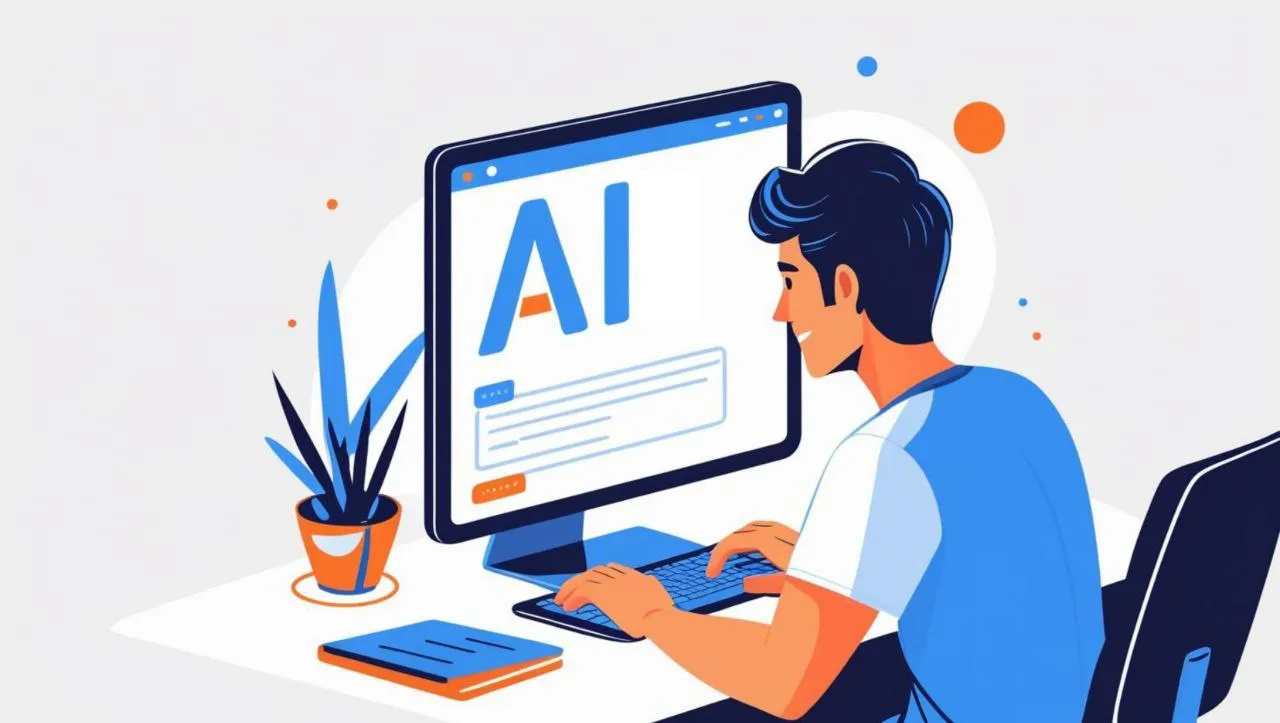
Vibe Coding & the Rise of Agentic AI in Software Development

Table of Contents
The software industry has long focused on automation for speeding up builds, deployments, testing, and workflows. But in 2025, the game is changing into something far smarter.
What’s emerging now is not just automation, but autonomy: agentic AI systems that can reason, plan, act, and even self-correct, all while collaborating with human developers.
This is no longer theory. From enterprise-scale projects to indie dev teams, agentic AI is entering active deployment. And it’s bringing new ways of thinking along with it, like “vibe coding,” a term being used by software teams to describe AI-powered development that's less rigid, more creative, and deeply contextual.
A Deeper Look Into Vibe Coding
Vibe coding refers to a new way of building software alongside AI systems that feel more like creative partners than tools.
-
The term has roots in flow-state programming, AI-assisted development, and even no-code culture.
-
It emphasises fluidity over rigidity, context over syntax, and exploration over structure.
-
Developers describe it as working “with” the machine, not just commanding it. This marks a shift from traditional tools to AI that codes alongside you, blending human creativity with autonomous coding assistance.
Unlike traditional workflows where tasks are planned and executed in mostly fixed steps, vibe coding allows for continuous feedback, context switching, and co-evolution of ideas between human and agent.
“The code doesn’t come from a prompt anymore,” says Sergey V., a full-stack software engineer at Magora. “It evolves from the conversation. You guide it like a partner, not a compiler.”
This shift is closely tied to a new class of intelligent systems: agentic AI.
Understanding Agentic AI in Dev Workflows
Agentic AI refers to AI systems that don’t just generate output on request; they act with a degree of autonomy.
What Makes AI “Agentic”?
Agentic systems are distinguished by several key traits:
-
Autonomy: The ability to act independently on a goal or task.
-
Memory: Persistent understanding of prior context, actions, and decisions.
-
Planning: Multi-step reasoning and goal decomposition.
-
Iterative feedback: Continuous learning from outcomes to improve performance.
These capabilities mark a leap from reactive chatbots to proactive collaborators.
Notable Tools Leading the Space:
-
AutoGPT and BabyAGI: Experimental agents that chain LLMs with tools and memory.
-
Devin (by Cognition): Marketed as the world’s first AI software engineer, capable of planning and shipping projects autonomously.
-
SWE-agent (by Princeton): Trained to autonomously fix GitHub issues by reading repos, proposing fixes, and running tests.
As these systems improve, developers are no longer just issuing instructions. They’re co-developing: Experimenting, iterating, and debugging side-by-side with AI. It’s no surprise then that Deloitte reports 25% of companies using generative AI will start agentic AI pilots in 2025, with that number expected to double by 2027 as more teams embrace this new way of working.
The Fusion: How Vibe Coding Meets Agentic AI
The way vibe coding and agentic AI come together is changing how software gets made. Developers are moving from strict commands to a more natural, back-and-forth style, brainstorming and tweaking ideas with the AI in real time.
This blend captures adaptive software development, where iterative cycles and responsiveness to change are key. Agentic AI’s autonomy and vibe coding’s conversational flow help teams refine solutions fast, without traditional development constraints.
This makes agentic AI a decision-making partner that:
-
Proposes alternatives
-
Revises its own output
-
Understands project context
-
Offers trade-offs and implications
As agentic AI systems mature, their role in decision-making is growing fast. In fact, Gartner predicts at least 15% of day-to-day work decisions will be made autonomously by agentic AI by 2028, up from almost none in 2024.
The developer’s role changes from just writing code to guiding the AI systems, managing ongoing feedback, and directing the big-picture decisions. It’s like having a conversation with the code – a dialogue that shapes the product in real time.
Benefits for Developers & Teams
Early adopters of this new workflow are reporting significant advantages. Many software development companies are already seeing faster prototyping and less mental overload as they bring agentic AI and vibe coding into their workflows.
1. Accelerated Prototyping
-
Agents can rapidly build interfaces, integrations, and pipelines.
-
Developers can test multiple ideas quickly, without starting from scratch.
2. Reduced Cognitive Load
-
Vibe coding offloads repetitive and boilerplate tasks.
-
Developers spend more time on architecture, UX, and design thinking.
3. Democratized Development
-
Non-traditional developers, such as designers, product managers, and domain experts, can now co-create software without deep technical knowledge.
-
This expands the contributor base and lowers the barrier to entry.
Challenges & Limitations
As with any new technology, agentic AI brings its own set of risks and trade-offs.
1. Loss of Control and Transparency
-
Agents sometimes make changes or decisions that are difficult to trace or interpret.
-
Without visibility into the reasoning process, debugging becomes complex.
2. Unpredictable Behaviour
-
Even advanced agents hallucinate code or introduce flawed logic.
-
Multi-agent systems can behave in non-deterministic ways when interacting with each other.
3. Ethical and Safety Concerns
-
There’s growing scrutiny around data provenance, intellectual property, and security in AI software development.
-
Autonomous systems could introduce vulnerabilities or biased logic without clear accountability.
Considering this, developers must remain in the loop. Not to micromanage, but to audit and override when needed.
Real-World Examples & Case Studies
Agent-based workflows, once confined to research labs, are now being adopted in real-world settings.
1. Game Development
Studios are using AI agents to:
-
Generate NPC behaviours.
-
Simulate quests.
-
Auto-test environments using autonomous play agents.
2. App and Web Dev
Startups are leveraging tools like GPT Engineer, OpenDevin, and Swe-agent to:
-
Scaffold full-stack apps.
-
Integrate APIs.
-
Write documentation and test cases on the fly.
3. Open Source Projects
GitHub repositories now include agents that:
-
Monitor issues and pull requests.
-
Suggest refactors.
-
Comment on code quality.
Recent research by MIT, Princeton, and the University of Pennsylvania saw a 26% increase in developer productivity after introducing an AI-assisted dev loop.
What This Means for the Future of Software Development
As agentic AI changes workflows, developers must now manage intelligent systems, curate data, and design human-AI interactions, moving from sole builders to systems architects guiding autonomous agents.
1. A Change in Skill Sets
Developers will need to master systems thinking, prompt design, and evaluating AI outputs. Syntax fluency will still help, but it won’t define expertise. Coding is important, but real value comes from big-picture thinking, smart oversight, and a strong sense of responsibility.
2. Rise of AI-Native Tools
We’re seeing early AI-native environments built for collaboration with autonomous systems. They prioritize interaction, offering tools to manage agents, track real-time input/output, and support communication through text, speech, code, and visuals.
Instead of just adding features to traditional IDEs, many of these tools are reimagining the whole workspace. The aim is to create a space where human insight and machine autonomy constantly adapt and work together.
3. Evolving Team Structures
With agentic systems in daily workflows, teams need new roles like “AI lead” or “agent wrangler” to manage performance and safety. Human-AI collaboration will become more dynamic, flexible, and multi-directional.
Why Working with an Expert Partner is the Way Forward
Agentic AI and vibe coding aren’t plug-and-play solutions. They require technical understanding and continuous oversight. From choosing the right tools to implementing safe workflows and staying compliant with evolving legal frameworks, the margin for error is real.
That’s why working with an experienced partner, like Magora, is so important. A team that understands not just AI models, but real-world development environments. One that can help you scale, avoid hidden risks, and design systems where autonomy enhances (not replaces) human judgment.
Final Thoughts
Vibe coding and agentic AI are now more than trends. They represent a complete change in how we think about collaboration and capability in software development.
By blending fluid, conversational workflows with autonomous AI, we’re creating a new kind of dev environment: faster, more inclusive, and deeply human-guided. But the questions are just beginning. How do we audit AI reasoning? What guardrails are needed? Who owns the code?
These are strategic and ethical concerns. That’s why it’s critical to work with expert partners; teams who understand both the opportunities and the risks, and can guide you through the technical, legal, and operational complexity.
Curious about implementing agentic AI in your development workflow? Reach out to our team. We’ll help you build smart, and keep the human in the loop.





